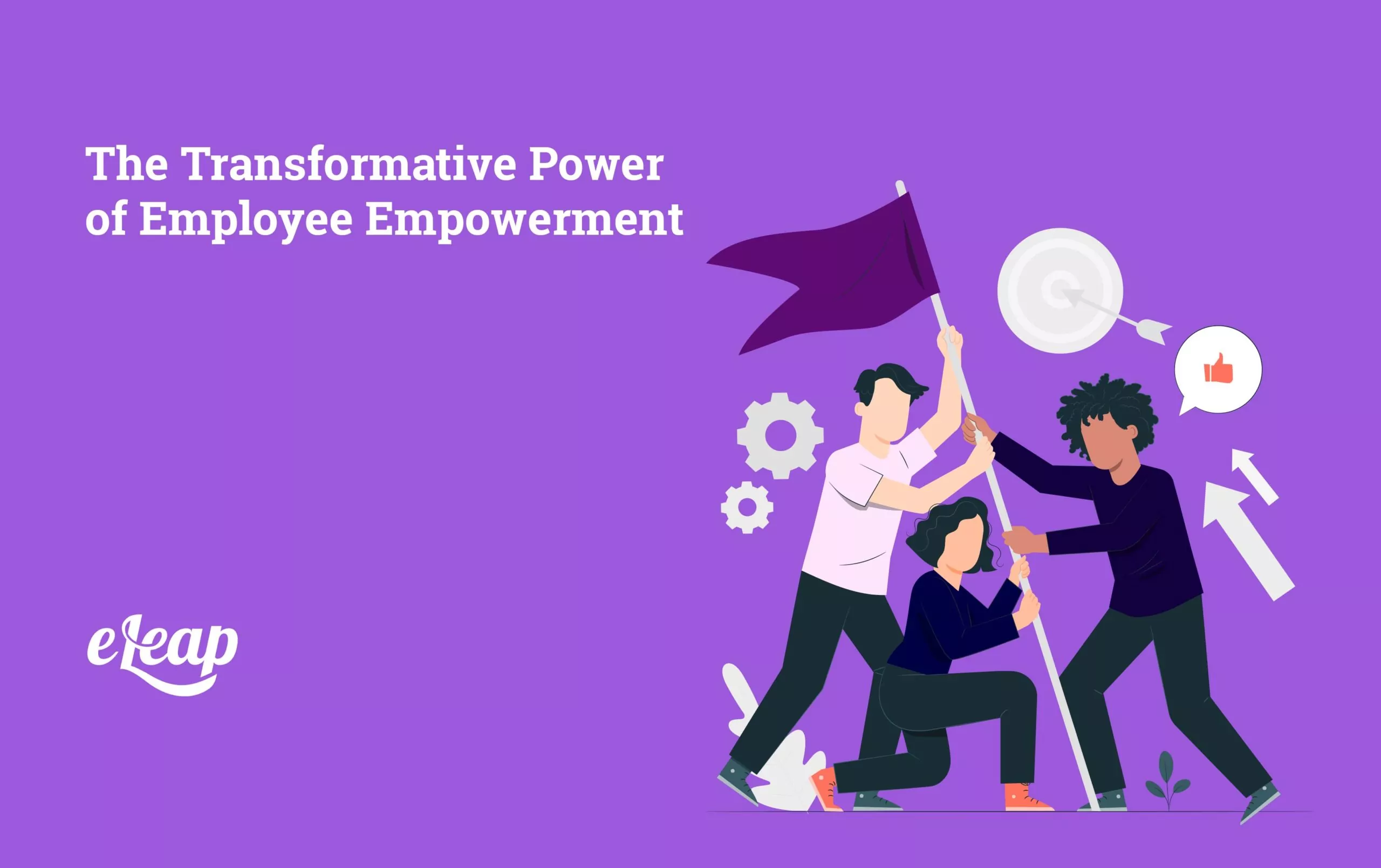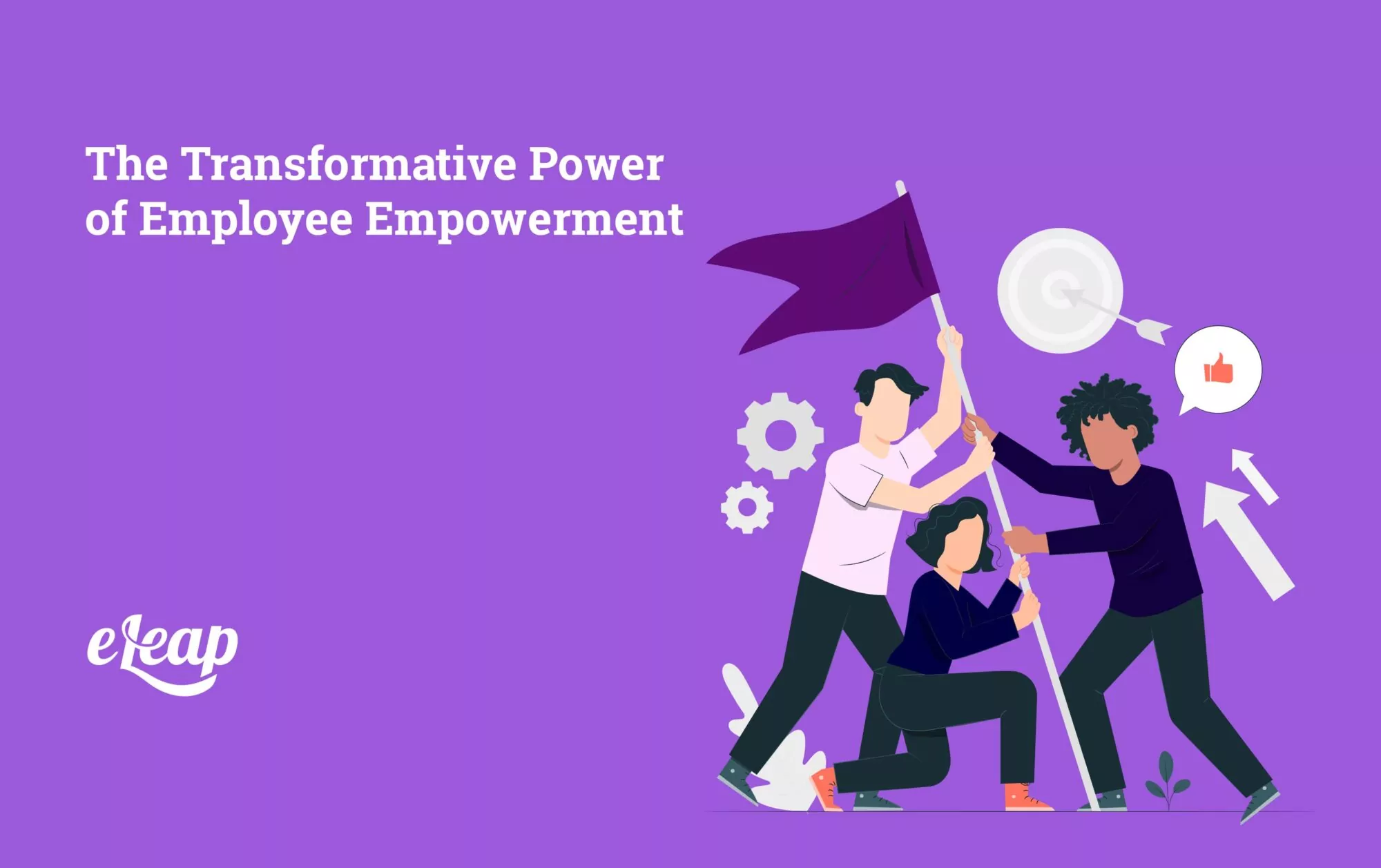The Transformative Power of Employee Empowerment

Employee empowerment is a key driver of organizational success. It plays a vital role in shaping workplace culture, improving productivity, and fostering innovation. The importance of employee empowerment cannot be overstated as businesses continue evolving in an increasingly dynamic environment. Empowering employees means offering autonomy and creating a culture that nurtures trust, growth, and collaboration. This article will explore what employee empowerment truly means, its transformative benefits, and practical strategies for successfully implementing it in the workplace. See how eLeaP’s Performance Management Platform helps you apply these insights to drive better results.
Defining Employee Empowerment
Employee empowerment gives employees the authority, resources, and confidence to make decisions about their work. It’s about enabling employees to take ownership of their tasks, allowing them to use their expertise, and trusting them to drive results. Empowered employees do not merely follow orders but are actively involved in decision-making, contributing ideas, and taking initiative.
This concept has evolved. Initially, empowerment was primarily associated with giving employees more control over their roles. It’s about fostering a more collaborative, transparent, and flexible workplace environment where employees feel trusted and valued.
Key Characteristics of Empowered Employees
Empowered employees display several defining characteristics that contribute to their organization’s success. These include:
- Decision-Making Authority: Empowered employees can make decisions that impact their work, whether choosing how to approach a task or influencing more extensive organizational strategies.
- Ownership and Accountability: Empowerment comes with a sense of responsibility. Empowered employees take full ownership of their tasks and the outcomes of their decisions.
- Access to Information: Empowered employees are given the tools and information to make informed decisions. Transparency in communication is critical to enabling this.
- Encouragement of Independent Thinking: Rather than being told what to do, empowered employees are encouraged to think critically, innovate, and develop new ideas.
The Transformative Benefits of Empowering Your Employees
Boosted Productivity and Performance
When employees feel empowered, they are more likely to perform at a higher level. Empowerment fosters a sense of pride and ownership, making employees more invested in their tasks. They are not just completing a checklist—they are actively engaged in achieving organizational goals.
Research consistently shows that empowered employees are more productive. A Gallup study found that organizations with high employee engagement (directly linked to empowerment) are 21% more productive than those with low engagement. Empowered employees take initiative, solve problems independently, and approach their work with greater purpose, increasing efficiency and output.
Enhanced Employee Engagement and Job Satisfaction

Employee empowerment is a key driver of employee engagement. When employees are trusted to make decisions and given the autonomy to perform their work, they feel more valued. Engaged employees are more satisfied with their jobs because they think their contributions matter and that they have control over their success.
Moreover, when employees can influence their work environment, they are more likely to have positive relationships with their colleagues and managers. This, in turn, builds a supportive and collaborative work culture that increases overall job satisfaction.
More muscular Employee Retention and Attraction of Top Talent
Empowered employees are less likely to leave an organization. According to a report by Gallup, disengaged employees are 3.5 times more likely to leave their jobs than engaged employees. Empowerment reduces turnover and attracts top talent. Highly skilled individuals are drawn to organizations that allow them to contribute meaningfully and give them a sense of autonomy in their work.
Companies that foster an empowered environment also develop a reputation as a great workplace. Employees who feel supported, valued, and trusted are more likely to stay long-term, reducing the cost and disruption associated with high turnover.
How Employee Empowerment Shapes Organizational Culture
Fostering a Culture of Trust and Collaboration
Building a culture of trust requires empowering employees. Empowering employees to make decisions shows that management trusts their judgment and values their expertise. Successful organizations build trust as a cornerstone of their culture. They focus not only on believing that employees will make the right choices but also on creating an environment where mistakes become learning opportunities and feedback remains constructive.
Empowerment also encourages collaboration. When employees are free to act and share their ideas, they are more likely to collaborate across departments, contribute to cross-functional teams, and support one another’s initiatives. The result is a more cohesive, collaborative work environment where communication flows freely and innovation thrives.
Increased Innovation and Creativity
Empowering employees gives them the freedom to innovate. When employees can think creatively and bring their ideas to the table, they are more likely to generate new solutions to old problems. In environments where employees feel stifled or micromanaged, innovation often stalls. However, in workplaces where employees are given the necessary tools and support, they are more inclined to experiment with new ideas, take risks, and contribute to the company’s growth.
A well-empowered team is one where creativity is encouraged and celebrated. Companies like Google and 3M have built their success on employee empowerment, creating cultures where innovation is not just allowed but expected.
Shifting from Top-Down to Bottom-Up Leadership
Traditional hierarchical leadership structures often focus on a top-down approach, where decision-making is concentrated at the organization’s top. Employee empowerment flips this model, encouraging a bottom-up approach where leadership is shared among all employees. This shift can lead to a more democratic, inclusive, and responsive organization.
In organizations with a bottom-up leadership model, employees at all levels can influence decisions, leading to faster decision-making, greater agility, and more accurate insights. Empowerment promotes a sense of shared leadership, where everyone feels that their voice matters.
Implementing Employee Empowerment: Proven Strategies for Success
Give Employees Ownership and Autonomy
Businesses must empower employees by giving them ownership over their work. This stage means not only giving employees the authority to make decisions but also allowing them to take full responsibility for the outcomes of their work. When employees are given autonomy, they feel more engaged and motivated to perform at their best.
Leaders should set clear expectations and provide the necessary resources but resist the urge to micromanage. Organizations foster creativity and innovation and boost morale by allowing employees to explore different ways of achieving goals.
Cultivate a Culture of Recognition and Feedback
Recognition is an essential component of empowerment. When employees are empowered to take ownership of their work, it’s important to acknowledge their contributions. Regular recognition reinforces positive behavior and motivates employees to continue striving for excellence.
Feedback also plays a critical role in employee empowerment. Constructive feedback allows employees to grow, learn from mistakes, and improve their performance. When leaders offer feedback in a supportive manner, it fosters an environment of continuous improvement.
Provide Opportunities for Professional Growth
Employee empowerment is closely linked to personal and professional growth. Empowered employees are more likely to seek opportunities for learning and development. Organizations can support this by offering training programs, mentorship opportunities, and career advancement paths.
Businesses value their employees’ growth and are committed to long-term success. Therefore, they invest in employee development, which benefits and enhances the organization’s overall performance by ensuring its workforce has the skills necessary to thrive in a competitive marketplace.
Navigating the Challenges of Employee Empowerment
Overcoming Resistance to Change
Despite its benefits, implementing employee empowerment can be met with resistance. Some employees and managers may feel uncomfortable with the shift toward more autonomy, particularly in organizations with deeply ingrained hierarchical structures. Overcoming this resistance requires clear communication about the benefits of empowerment and addressing any concerns that arise.
Leaders should proactively explain the vision behind empowerment and provide examples of successful implementations. Organizations can reduce resistance and gain buy-in from all levels by encouraging open dialogue and involving employees.
Ensuring Empowerment is Equitable Across All Teams
To make employee empowerment truly effective, organizations must implement it equitably across all areas. The organizational culture must embrace empowerment, ensuring it is not restricted to specific departments or individuals. Leaders must provide equal opportunities for all employees, regardless of their role or position, to contribute, make decisions, and take ownership of their work.
Equity in empowerment also means recognizing and addressing potential barriers to empowerment for underrepresented groups. This process may involve training programs, mentorship, and fostering a more inclusive environment where every employee feels valued and empowered.
Real-Life Success Stories: How Leading Companies are Reaping the Benefits
Case Study 1: Tech Industry Leader
Case Study 2: Global Retail Brand
A major global retail brand embraced empowerment by allowing store managers to make operational decisions and implement local promotions. This level of autonomy improved the stores’ responsiveness to customer needs, leading to increased sales and customer satisfaction. Employees felt more motivated as they saw their decisions directly impact business outcomes.
Case Study 3: Healthcare Organization
A healthcare organization empowers its staff by allowing nurses and physicians to make decisions regarding patient care protocols. This autonomy led to improved patient outcomes and a stronger sense of ownership among healthcare professionals. The result was better patient care, higher employee satisfaction, and improved retention rates.
Measuring the Impact of Employee Empowerment: Metrics That Matter
Key Performance Indicators (KPIs) to Track
Organizations should track several key performance indicators (KPIs) to assess employee empowerment’s success. These include:
- Employee Engagement Scores: Regular surveys measure employees’ engagement and whether they feel empowered.
- Employee Retention: Decreased turnover rates indicate employees feel valued and empowered.
- Productivity and Performance: Monitoring productivity metrics can help gauge the effectiveness of empowerment initiatives.
Tools for Measuring Success
Several tools can help organizations measure the impact of employee empowerment. Feedback platforms, employee engagement surveys, and performance management software can provide valuable insights into employee sentiment, productivity, and overall organizational success.
The Future of Employee Empowerment: Trends and Innovations
The Role of Technology in Empowerment
Technology is increasingly important in employee empowerment. Digital tools like project management software, communication platforms, and training resources allow employees to control their tasks more effectively and collaborate with their teams more effectively. For example, platforms like eLeaP are revolutionizing employee training by offering personalized learning experiences that empower employees to take charge of their professional development.
Empowerment and the Rise of Hybrid Work Models
As remote and hybrid work models continue to gain popularity, empowering employees in these environments becomes even more critical. Giving employees the tools, autonomy, and trust to manage their work from anywhere is key to maintaining high levels of engagement and productivity.
A Look Toward the Future
Looking ahead, employee empowerment will continue to evolve as businesses embrace new technologies and work models. The future of empowerment lies in creating more flexible, inclusive, and collaborative work environments where employees at all levels feel that they have the power to influence their work and contribute meaningfully to the organization.
Conclusion
Employee empowerment is a transformative practice that can significantly impact an organization’s success. By fostering a culture of trust, collaboration, and autonomy, businesses can boost productivity, improve employee satisfaction, and retain top talent. Implementing employee empowerment requires thoughtful strategies, leadership commitment, and an emphasis on professional development. As organizations continue to evolve, the power of empowerment will be central to achieving long-term growth and success.